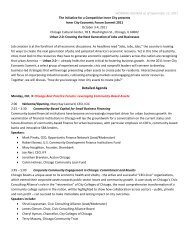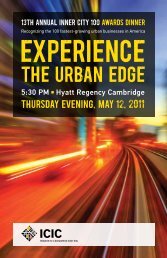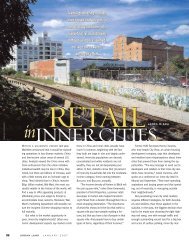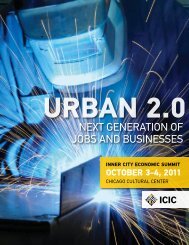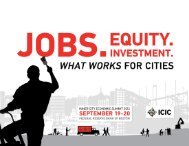Opportunity Newark - Initiative for a Competitive Inner City
Opportunity Newark - Initiative for a Competitive Inner City
Opportunity Newark - Initiative for a Competitive Inner City
Create successful ePaper yourself
Turn your PDF publications into a flip-book with our unique Google optimized e-Paper software.
However, while <strong>Newark</strong>’s strongest employment bases are<br />
built off of the city’s key assets, data shows that there has<br />
been little employment growth in these clusters <strong>for</strong> the<br />
period from 1998–2003. TLD, <strong>for</strong> example, grew at a modest<br />
1 percent compounded annual growth rate (CAGR) <strong>for</strong> the<br />
1998–2003 period. Likewise, Health Services grew by only<br />
2 percent over the same period. While <strong>Newark</strong>’s 3,000-plus<br />
businesses collectively employ more than 95,000 people,<br />
additional resources and alignment of current development<br />
projects can help increase <strong>Newark</strong>’s employment growth in<br />
these key areas.<br />
Demographic Profile<br />
<strong>Newark</strong> is home to an incredibly diverse population. Almost<br />
90 percent of <strong>Newark</strong>’s total population consists of minorities,<br />
compared to 35 percent in the region. Additionally,<br />
the increase in the Latino population is accountable <strong>for</strong><br />
stabilizing <strong>Newark</strong>’s decades of population decline. From<br />
1990 to 2000, while the white and black populations in<br />
<strong>Newark</strong> fell 15 percent and 8 percent, respectively, the<br />
Hispanic population rose by 16 percent. 4<br />
<strong>Newark</strong>’s population has also been increasing in educational<br />
attainment, yet there is still room <strong>for</strong> improvement.<br />
From 1990 to 2000, the number of <strong>Newark</strong> residents who<br />
had achieved some degree of college education increased<br />
by more than 25 percent in <strong>Newark</strong>, more than twice the<br />
gain shown in the remainder of Essex County. 5 In the same<br />
timeframe, the number of <strong>Newark</strong> residents with less than<br />
a high school diploma declined by almost 13 percent. 6<br />
However, with 41 percent of <strong>Newark</strong> residents still lacking<br />
even a high school degree or equivalent, the city must<br />
continue to focus on helping its residents attain higher<br />
degrees of education. 7<br />
the economic boom of the 1990s, <strong>Newark</strong>’s poverty rate<br />
increased from 26 percent to 28 percent from 1990 to<br />
2000. 8 The city’s poverty rate is the second highest in the<br />
state and three times the national average.<br />
While <strong>Newark</strong>’s diverse ethnic community is a potential<br />
resource in an increasingly global economy, the educational<br />
and work<strong>for</strong>ce indicators raise a need <strong>for</strong> <strong>Newark</strong>’s<br />
redevelopment ef<strong>for</strong>ts to be linked to the community to<br />
ensure that while the city flourishes, the residents share<br />
in the rewards.<br />
The Need<br />
Redevelopment ef<strong>for</strong>ts– such as the addition of new cultural<br />
centers; bright, safe, and inviting streetscapes; and<br />
improved infrastructure– are intended to improve a location’s<br />
economy and the futures of the people who live there.<br />
It is even more important, however, <strong>for</strong> leaders to couple<br />
their redevelopment ef<strong>for</strong>ts with serious attention to the<br />
educational and employment needs of the community.<br />
<strong>Opportunity</strong><strong>Newark</strong>’s goal is to ensure that this vital connection<br />
occurs in <strong>Newark</strong>. The demographic profile described<br />
above amplifies the urgency of addressing unemployment<br />
and underemployment in order to help <strong>Newark</strong> residents<br />
capitalize on the opportunities inherent in the city’s revitalization.<br />
The project’s objective is to help connect current<br />
redevelopment ef<strong>for</strong>ts so that local residents are ready and<br />
Within the labor <strong>for</strong>ce, there is a need to link <strong>Newark</strong> workers<br />
to <strong>Newark</strong> jobs. While 41 percent of <strong>Newark</strong>’s active<br />
labor <strong>for</strong>ce works in <strong>Newark</strong>, <strong>Newark</strong> residents hold only 25<br />
percent of local jobs. Clearly, there needs to be additional<br />
emphasis placed on ensuring <strong>Newark</strong> residents have the<br />
skills and access to obtain jobs within the city. Increasing<br />
the linkages between <strong>Newark</strong> workers and jobs is essential<br />
if the city is to combat rising poverty rates. Despite<br />
4 1990 US Census, 2000 US Census.<br />
5 Ibid.<br />
6 Ibid.<br />
7 Ibid.<br />
8 Ibid.<br />
<strong>Opportunity</strong><strong>Newark</strong>: Jobs and Community Development <strong>for</strong> the 21st Century



